Source: World Socialist Web Site
By
Clare Hurley
Picasso Sculpture; an exhibition at the Museum of Modern Art (MoMA), New York City through February 7, 2016
Is yet another major and uncritical exhibition of Picasso’s work really called for? During his lifetime Picasso (1881-1973) was likely the most famous artist to have ever lived. Forty-two years after his death, he remains—as art critic John Berger observed in his Success and Failure of Picasso —one of the few artists whose name most people in the world recognize, even if far fewer could actually recognize his artwork.
According to a web site devoted to the artist, there are at any given time “perhaps dozens of exhibitions worldwide that feature Picasso, either on his own, or as part of a group show.” And of course his artwork is widely reproduced and imitated.
Unfortunately, the Museum of Modern Art’s current exhibit of Picasso’s sculpture—the first major US museum survey in the last 50 years—fails to communicate anything particularly significant about the legendary artist’s interpretation of the social reality and times through which he lived. Or not much that could not have been done in a much more modest show.
Instead MoMA has given Picasso’s sculpture blockbuster treatment,
including more than 140 pieces, many of them repetitive or of negligible
quality. The handful of sculptures that are a discovery tend
to get lost in the crowd. And of course, the exhibition, presented as an
opportunity to see a more “intimate” side of the artist, is very
crowded, the timed-admission tickets notwithstanding. In this, as in
many instances in the Picasso exhibition, the scale seems to be off.
Chronologically, one begins at the end, with Picasso’s sheet metal sculptures from the 1950s–60s displayed in the balcony area that serves as an entrance to the main exhibition galleries. Here the relatively small size of these pieces belies the fact that many, like Maquette for Richard J. Daley Center Sculpture (1964), intended as a portrait of Picasso’s wife Jacqueline though it suggests equally a dog or horse’s head, are models for pieces that were ultimately realized over ten times larger as commissions for public spaces.
Indeed, the question of scale taken as a function of perspective, i.e., of relative as opposed to absolute size, is key to Picasso’s work, his paintings as well as his sculpture. For the artist, the scale of features and body parts, once freed from the dictates of realistic proportions, could be as large or small—or completely absent—as his emotional, and most often sexual desires dictated.
The justification for this, asserted through all Picasso’s restless multiplicity of styles, was supposed to be a thorough rejection of the aesthetic traditions that had evolved over centuries of Western art as a means of conveying the content of life.
The issues bound up with Picasso’s career are very complex. His
genius, reflected in his early painting in particular, is not in
dispute. Moreover, a great deal of liberating energy was released in the
decade preceding the first World War as part of a broad cultural shift
reflecting the gathering economic and political tensions that were soon
to erupt in war and revolution. However, for reasons that were not the
fault of the artists it is questionable whether a radical new
understanding of the world and its artistic representation, as was
promised and proclaimed, ever came fully to pass. A great many processes
were still-born as the result of social developments originating
outside the realm of art.
Among the earliest works (1902–09) are small wooden figurines that indicate Picasso’s interest, shared with other early modernists, in African art, which would play a transformative role in how they represented the human figure. The expressive and symbolic qualities of bodily features was emphasized over naturalistic proportions, in an effort to reject the conventions of Western art in favor of something considered more pure, primal and direct.
As developed by Picasso together with fellow painter Georges Braque (1882–1963), cubism’s breaking up of form into facets was supposed to analyze a form’s existence in two-dimensional space by simultaneously showing a multiplicity of views. Woman ’s Head, Fernande (1909)—of Picasso’s mistress—is perhaps the best known cubist sculpture.
Again, one has to be critical of, or at least raise questions about, the sweeping claims made for cubism, which often have a one-sided or even clichéd character. No doubt a variety of political, cultural and scientific developments [including Einstein’s breakthrough in 1905] fed into its emergence. Typically, critic Klaus Honnef writes that behind cubism and related trends were “dynamic” changes that had reached the cultural world and “sharpened the awareness of receptive minds to the fact that the one-point perspective arrangement of painting was merely feigning an illusory fictitious world of reality.”
The last part of this comment, referring to “an illusory fictitious
world of reality,” is telling. The scientific advances of the turn of
the 20th century, for example, fell on an artistic-intellectual world
that was to a great extent under the influence of Nietzscheanism and
other irrationalist or subjectivist trends, including Machism, which
called into question or denied the existence of a world existing
independently of the artist/viewer’s perception.
Ultimately, hemmed in by the defeats of revolution and the rise of Stalinism, Picasso and the avant-garde circles who pioneered 20th century modern art were directed—and directed themselves—back primarily to the inner, subjective world of the artist, to his or her impressions, to a world that came to be ever more constricted in its content till it lost much of its resonance with a broader audience. This development can be traced through in the current show.
The chronology of the exhibition skips from 1915 to 1927, reflecting Picasso’s 14-year hiatus from sculpture, which coincides with the period of the First World War and its aftermath. His return to sculpture came in the form of a commission for a monument to the poet and art critic Guillaume Apollinaire, the close friend and intellectual mentor of the Parisian avant-garde who is credited with having coined the terms and elaborated the artistic conceptions of “cubism” and “surrealism.”
Wounded in battle, Apollinaire’s death from Spanish flu in 1918
shattered the insularity of the bohemian circle in Paris. A sense of
dislocation and horror at the mass slaughter of modern warfare
inescapably marked the generation, whether or not a given artist had
served in the trenches. Braque, who became a French patriot, had.
Picasso, a pacifist, as a Spanish national was exempted.
It took Picasso over four years to create his monument to Apollinaire, a structure “defined by voids as much as by solids,” an idea he drew from Apollinaire’s book Le Poète assassiné (1916). Picasso’s Woman in the Garden (1929–30) is a fanciful, somewhat startled-looking bird-creature made of bits of scrap metal coupled with household objects, oddly lacking the gravitas one would expect in a monument to a significant artistic figure and friend.
The next section of the exhibit, named after the Boisgeloup sculpture studio (40 miles outside Paris), where Picasso worked from 1930–37, is a radical departure in style from the previous one. In the post-World War I period, Picasso and other artists reintroduced classical Greek sculpture and other traditional motifs which they had vigorously rejected before the war to indicate a “return to order,” while maintaining the exaggerated, simplified proportions that had come to define modern art. Picasso’s startling Head of a Woman (1932) combines the voluptuous fullness of stone (here displayed in a plaster cast of the final piece) with a birdlike crest for a nose and etched eye that suggests an anomalously bulbous Cycladic head.
During World War II, Picasso’s international stature ensured that he was one of the few artists deemed “degenerate” by the Nazis who were allowed to stay in occupied Paris after he refused offers to emigrate. From the sculpture in the section “The War Years (1939–45),” one can discern little of the artist’s bitter hostility to the Nazi regime; one mostly gets a sense of the artist’s isolation and his making due with little, albeit brilliantly. Bull’s Head (1942) is simply the seat and handlebars of a bicycle, which he did not alter, cleverly arranged together. More evocatively, Death’s Head (1941) suggests a molten cannonball.
It is ironic that no traces of Picasso’s painting Guernica
(1937) find expression in three-dimensional form. His artistic response
to news of the German and Italian fascist bombing of civilians in the
Basque village in April 1937, which was at the center of resistance to
Franco, became and continues to be one of the greatest anti-war
paintings. Allegedly when Nazi officers came into his apartment in Paris
and saw a photograph of Guernica, one of them remarked, “This painting, you did this?” “No,” replied Picasso. “You did this.”
Painted as a commission by the Spanish Republican government for the Spanish Pavilion at the 1937 Paris International Exhibition, the painting toured the US after Franco’s victory in 1939, as part of Popular Front campaigns to raise money for Spanish refugees. It continued travelling in response to popular demand until concerns over its physical condition led to its installation at MoMA in 1956. Fiercely anti-fascist throughout his lifetime, Picasso refused to allow the painting to return to Spain as long as Franco remained in power; it was only returned to Spain in 1981. Repeatedly copied and reproduced, Guernica’s harrowing image of the “collateral” human suffering of war is still able to rankle imperialist war-mongers. A tapestry copy hanging in the United Nations had to be covered in 2003 when the Security Council was discussing war on Iraq. Not that it stopped them.
The postwar period of Picasso’s sculpture feels decidedly less original. By this time, the once iconoclastic artist had become a legendary “personality,” whose own fabulous wealth was such that he was able to purchase a house in the south of France with the sale of a single painting. The large-scale commissions of anthropomorphic creatures out of sheet metal produced for public spaces in the United States and Europe seem complacently “modern,” as modernism had become the officially sanctioned style of the postwar boom of the 1950s-early 1960s.
In Apollinaire’s only book on art, The Cubist Painters, Aesthetic Meditations, a collection of notes and observations, he wrote, “a man like Picasso studies an object as a surgeon dissects a cadaver.” Though intended no doubt to describe the artist’s objectivity, the remark perhaps unintentionally says more about the chilly quality of Picasso’s “greatest” work which often fails to move one.
However, at its best, Picasso’s sculpture can still surprise and delight. His ability to see ordinary objects in radically transformed ways often manifested itself in his inventive use of corrugated cardboard, chicken wire, nails, screws and string in such pieces as Woman with Leaves (1934), The Orator (1933–34), and Woman with Orange/Apple (1934) to suggest a race of hybrid creatures, only part human, metamorphosed out of ordinary, everyday materials. Others, like the delightful Little Horse (circa 1960) made by Picasso as a toy for his son, are genuinely intimate, and not really “sculpture” at all.
Picasso’s sculpture at the Museum of Modern Art in New York
By
Clare Hurley
18 January 2016
Picasso Sculpture; an exhibition at the Museum of Modern Art (MoMA), New York City through February 7, 2016Is yet another major and uncritical exhibition of Picasso’s work really called for? During his lifetime Picasso (1881-1973) was likely the most famous artist to have ever lived. Forty-two years after his death, he remains—as art critic John Berger observed in his Success and Failure of Picasso —one of the few artists whose name most people in the world recognize, even if far fewer could actually recognize his artwork.
According to a web site devoted to the artist, there are at any given time “perhaps dozens of exhibitions worldwide that feature Picasso, either on his own, or as part of a group show.” And of course his artwork is widely reproduced and imitated.
Unfortunately, the Museum of Modern Art’s current exhibit of Picasso’s sculpture—the first major US museum survey in the last 50 years—fails to communicate anything particularly significant about the legendary artist’s interpretation of the social reality and times through which he lived. Or not much that could not have been done in a much more modest show.
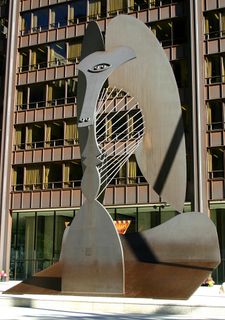 |
| Chicago Picasso (1967) |
Chronologically, one begins at the end, with Picasso’s sheet metal sculptures from the 1950s–60s displayed in the balcony area that serves as an entrance to the main exhibition galleries. Here the relatively small size of these pieces belies the fact that many, like Maquette for Richard J. Daley Center Sculpture (1964), intended as a portrait of Picasso’s wife Jacqueline though it suggests equally a dog or horse’s head, are models for pieces that were ultimately realized over ten times larger as commissions for public spaces.
Indeed, the question of scale taken as a function of perspective, i.e., of relative as opposed to absolute size, is key to Picasso’s work, his paintings as well as his sculpture. For the artist, the scale of features and body parts, once freed from the dictates of realistic proportions, could be as large or small—or completely absent—as his emotional, and most often sexual desires dictated.
The justification for this, asserted through all Picasso’s restless multiplicity of styles, was supposed to be a thorough rejection of the aesthetic traditions that had evolved over centuries of Western art as a means of conveying the content of life.
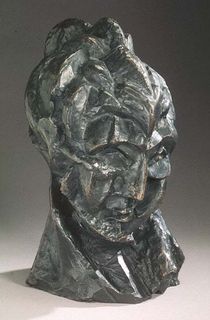 |
| Woman's Head, Fernande (1909) |
Among the earliest works (1902–09) are small wooden figurines that indicate Picasso’s interest, shared with other early modernists, in African art, which would play a transformative role in how they represented the human figure. The expressive and symbolic qualities of bodily features was emphasized over naturalistic proportions, in an effort to reject the conventions of Western art in favor of something considered more pure, primal and direct.
As developed by Picasso together with fellow painter Georges Braque (1882–1963), cubism’s breaking up of form into facets was supposed to analyze a form’s existence in two-dimensional space by simultaneously showing a multiplicity of views. Woman ’s Head, Fernande (1909)—of Picasso’s mistress—is perhaps the best known cubist sculpture.
Again, one has to be critical of, or at least raise questions about, the sweeping claims made for cubism, which often have a one-sided or even clichéd character. No doubt a variety of political, cultural and scientific developments [including Einstein’s breakthrough in 1905] fed into its emergence. Typically, critic Klaus Honnef writes that behind cubism and related trends were “dynamic” changes that had reached the cultural world and “sharpened the awareness of receptive minds to the fact that the one-point perspective arrangement of painting was merely feigning an illusory fictitious world of reality.”
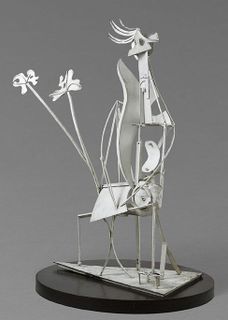 | |
| Woman in the Garden (1929–30) |
Ultimately, hemmed in by the defeats of revolution and the rise of Stalinism, Picasso and the avant-garde circles who pioneered 20th century modern art were directed—and directed themselves—back primarily to the inner, subjective world of the artist, to his or her impressions, to a world that came to be ever more constricted in its content till it lost much of its resonance with a broader audience. This development can be traced through in the current show.
The chronology of the exhibition skips from 1915 to 1927, reflecting Picasso’s 14-year hiatus from sculpture, which coincides with the period of the First World War and its aftermath. His return to sculpture came in the form of a commission for a monument to the poet and art critic Guillaume Apollinaire, the close friend and intellectual mentor of the Parisian avant-garde who is credited with having coined the terms and elaborated the artistic conceptions of “cubism” and “surrealism.”
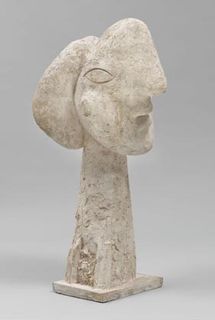 |
| Head of a Woman (1932) |
It took Picasso over four years to create his monument to Apollinaire, a structure “defined by voids as much as by solids,” an idea he drew from Apollinaire’s book Le Poète assassiné (1916). Picasso’s Woman in the Garden (1929–30) is a fanciful, somewhat startled-looking bird-creature made of bits of scrap metal coupled with household objects, oddly lacking the gravitas one would expect in a monument to a significant artistic figure and friend.
The next section of the exhibit, named after the Boisgeloup sculpture studio (40 miles outside Paris), where Picasso worked from 1930–37, is a radical departure in style from the previous one. In the post-World War I period, Picasso and other artists reintroduced classical Greek sculpture and other traditional motifs which they had vigorously rejected before the war to indicate a “return to order,” while maintaining the exaggerated, simplified proportions that had come to define modern art. Picasso’s startling Head of a Woman (1932) combines the voluptuous fullness of stone (here displayed in a plaster cast of the final piece) with a birdlike crest for a nose and etched eye that suggests an anomalously bulbous Cycladic head.
During World War II, Picasso’s international stature ensured that he was one of the few artists deemed “degenerate” by the Nazis who were allowed to stay in occupied Paris after he refused offers to emigrate. From the sculpture in the section “The War Years (1939–45),” one can discern little of the artist’s bitter hostility to the Nazi regime; one mostly gets a sense of the artist’s isolation and his making due with little, albeit brilliantly. Bull’s Head (1942) is simply the seat and handlebars of a bicycle, which he did not alter, cleverly arranged together. More evocatively, Death’s Head (1941) suggests a molten cannonball.
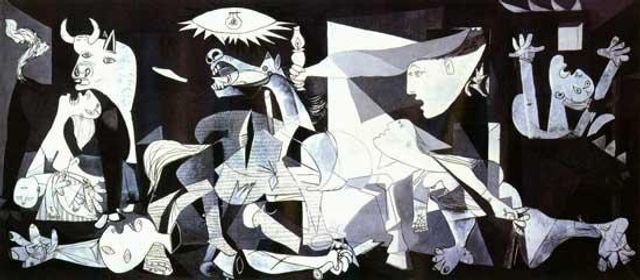 |
| Guernica (1937) |
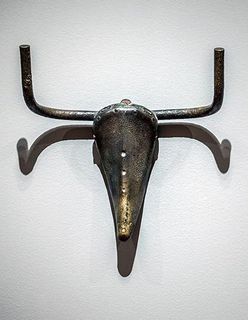 |
| Bull's Head (1942) |
Painted as a commission by the Spanish Republican government for the Spanish Pavilion at the 1937 Paris International Exhibition, the painting toured the US after Franco’s victory in 1939, as part of Popular Front campaigns to raise money for Spanish refugees. It continued travelling in response to popular demand until concerns over its physical condition led to its installation at MoMA in 1956. Fiercely anti-fascist throughout his lifetime, Picasso refused to allow the painting to return to Spain as long as Franco remained in power; it was only returned to Spain in 1981. Repeatedly copied and reproduced, Guernica’s harrowing image of the “collateral” human suffering of war is still able to rankle imperialist war-mongers. A tapestry copy hanging in the United Nations had to be covered in 2003 when the Security Council was discussing war on Iraq. Not that it stopped them.
The postwar period of Picasso’s sculpture feels decidedly less original. By this time, the once iconoclastic artist had become a legendary “personality,” whose own fabulous wealth was such that he was able to purchase a house in the south of France with the sale of a single painting. The large-scale commissions of anthropomorphic creatures out of sheet metal produced for public spaces in the United States and Europe seem complacently “modern,” as modernism had become the officially sanctioned style of the postwar boom of the 1950s-early 1960s.
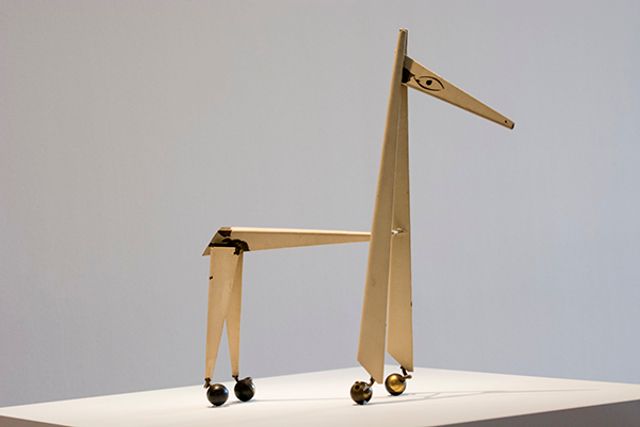 |
| Little Horse (circa 1960) |
In Apollinaire’s only book on art, The Cubist Painters, Aesthetic Meditations, a collection of notes and observations, he wrote, “a man like Picasso studies an object as a surgeon dissects a cadaver.” Though intended no doubt to describe the artist’s objectivity, the remark perhaps unintentionally says more about the chilly quality of Picasso’s “greatest” work which often fails to move one.
However, at its best, Picasso’s sculpture can still surprise and delight. His ability to see ordinary objects in radically transformed ways often manifested itself in his inventive use of corrugated cardboard, chicken wire, nails, screws and string in such pieces as Woman with Leaves (1934), The Orator (1933–34), and Woman with Orange/Apple (1934) to suggest a race of hybrid creatures, only part human, metamorphosed out of ordinary, everyday materials. Others, like the delightful Little Horse (circa 1960) made by Picasso as a toy for his son, are genuinely intimate, and not really “sculpture” at all.
No comments:
Post a Comment